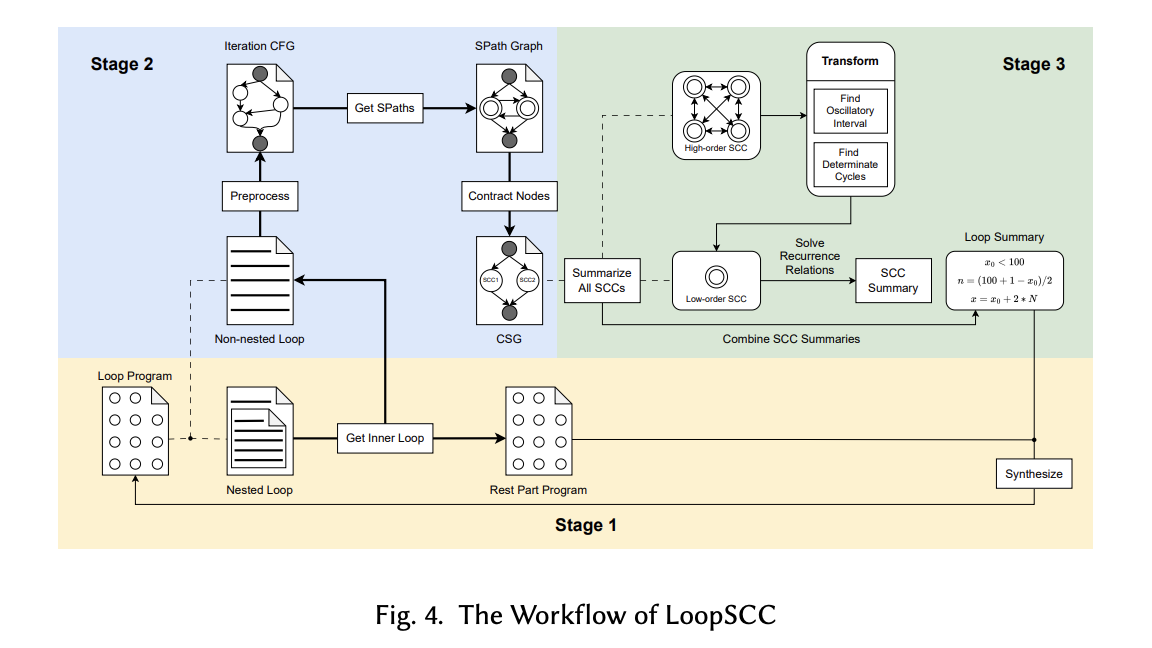

Analyzing loops with difficult control flows is a challenging problem that has long stood for over two decades in program verification and software analysis. Challenges associated with the non-deterministic number of iterations and potentially exponential growth of control flow paths arise, especially for multi-branch loops. Traditional methods for loop analysis either oversimplify these structures, resulting in loss of critical information, or are computationally infeasible due to path explosion. Since loops lie at the heart of many critical applications, such as compilers, program analyzers, and verification tools, overcoming these challenges is fundamentally important for enhancing the precision and efficiency of software analysis.
Existing techniques for loop summarization fall into one of two categories: abstract interpretation or concrete interpretation. Abstract interpretation aims at the approximation of the loop behavior by constructing new program structures that may not represent the true semantics of the original program. Such an approach very often leads to a loss of information and incomplete analysis. Concrete interpretation tries to keep the exact semantics of the loop’s behavior, though it suffers from problems with undecidability, particularly when dealing with multi-branch loops with irregular transitions between the branches. Symbolic execution and model-checking techniques are severely limited by path explosion in the case of multi-branch loops, and summarization methods like Proteus and WSummarizer fail most of the time when the looping can contain complex, irregular branching patterns.
The researchers from the Institute of Information Engineering and Nankai University present LoopSCC – a novel method for dealing with multi-branch loops with irregular transitions of control flows. The process first unfolds the nested forms of loops in a non-nested form, simplifying the loop structure. Then, applying SCC, the control flow reduces to a more efficient and detailed expression – that is, to the Contracted Single-Loop-Path Graph (CSG). This approach involves “oscillatory intervals” that reflect periodic types of iterations within loops, thereby ensuring a correct summary even when the control paths are irregular. It is a direct innovation of this mechanism against the limitations that were inherent in earlier methods. It has given a very precise and efficient solution for complex structures of loops.
LoopSCC operates on nested loops that are transformed into non-nested forms by applying Gaussian elimination techniques. Finally, the SCC-based control flow representation is abstracted, and multi-path loops are translated into less complex structures which could then be summarized. CSG creation overall plays a vital role in the breakdown of complex control flows, and oscillatory intervals make the method able to summarize loops whose transitions between branches are not in the standard pattern. The researchers conducted extensive experiments on public datasets such as C4B and real-world programs, including Bitcoin and musl to show superior accuracy and scalability as compared to other existing tools.
LoopSCC shows better performance as compared to existing methods in terms of both accuracy and scalability. It achieved 100% accuracy on standard benchmarks, placing it above popular tools such as CBMC, CPAchecker, ICRA, and VeriAbsL, among the other state-of-the-art loop summarization methods, namely Proteus and WSummarizer. It also successfully handled an extensive array of loop types, especially complex multi-branch loops with difficult control flow, that other approaches couldn’t represent and summarize efficiently. In large-scale real-world software, such as Bitcoin and musl, LoopSCC can summarize 81.5% of the loops, demonstrating outstanding scalability and practical applicability in handling real-world programming challenges.
LoopSCC offers significant advances in loop summarization since they efficiently address the intricacies of multi-branch loops with irregular transitions. Using SCC-based graph contraction along with oscillation interval detection, it is an accurate and scalable solution that outperforms the existing methods in terms of both precision and applicability in practice. This technique may improve the functionality of program verification and software analysis tools enormously, where it solves one of the toughest problems in loop analysis robustly.
Check out the Paper. All credit for this research goes to the researchers of this project. Also, don’t forget to follow us on Twitter and join our Telegram Channel and LinkedIn Group. If you like our work, you will love our newsletter.. Don’t Forget to join our 55k+ ML SubReddit.
[Upcoming Live LinkedIn event] ‘One Platform, Multimodal Possibilities,’ where Encord CEO Eric Landau and Head of Product Engineering, Justin Sharps will talk how they are reinventing data development process to help teams build game-changing multimodal AI models, fast‘
The post LoopSCC: A Novel Loop Summarization Technique to Achieve Concrete Semantic Interpretation on Complex Loop appeared first on MarkTechPost.